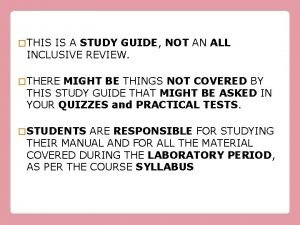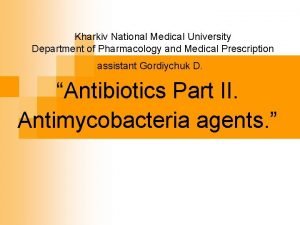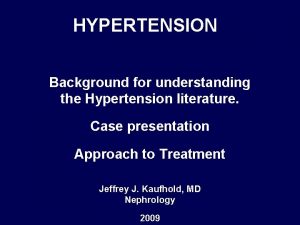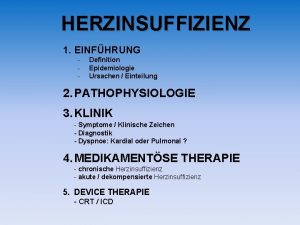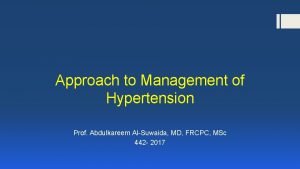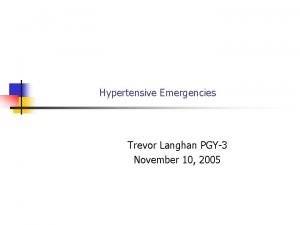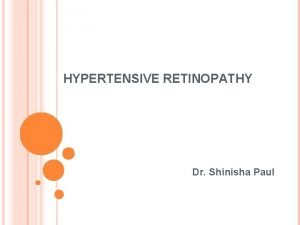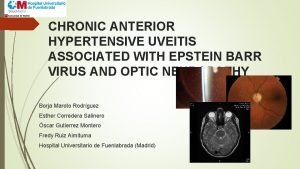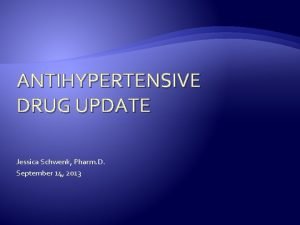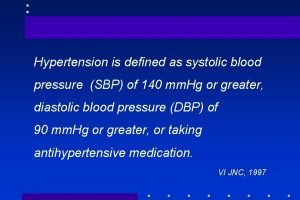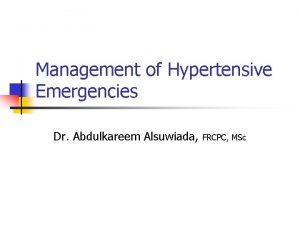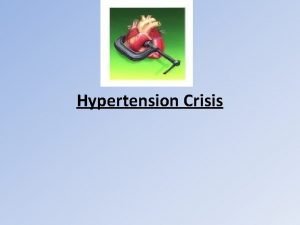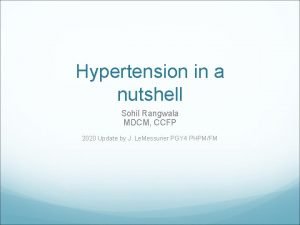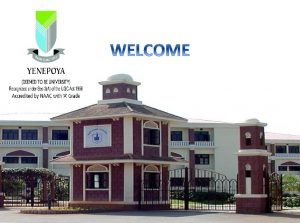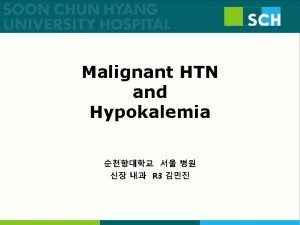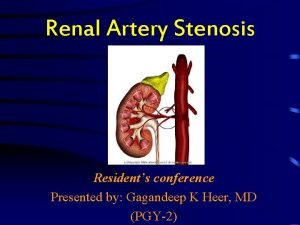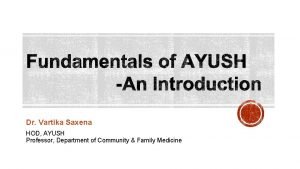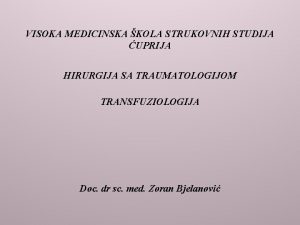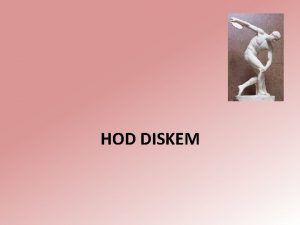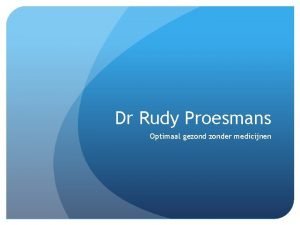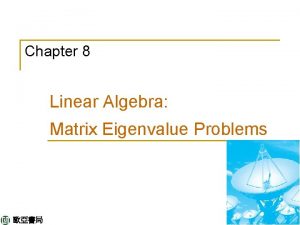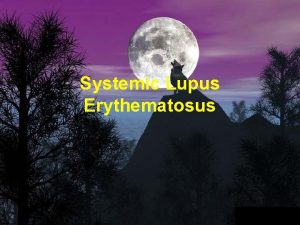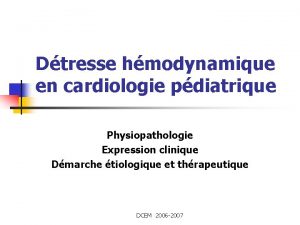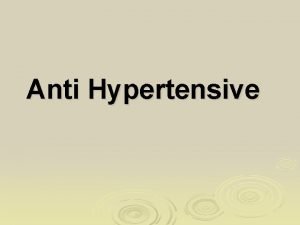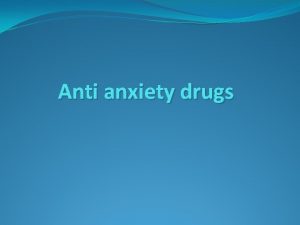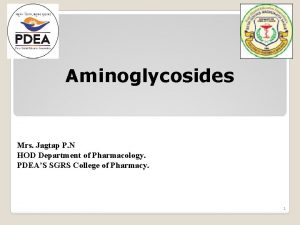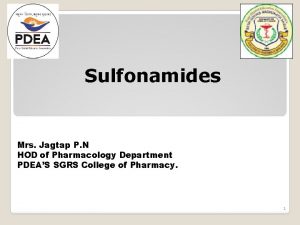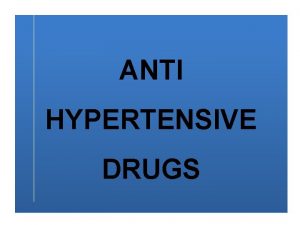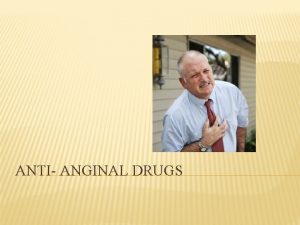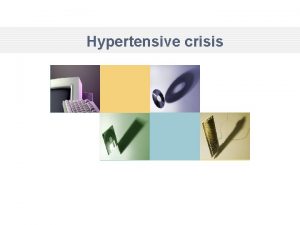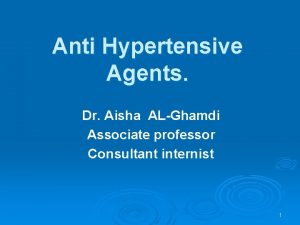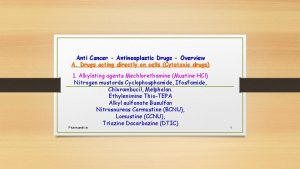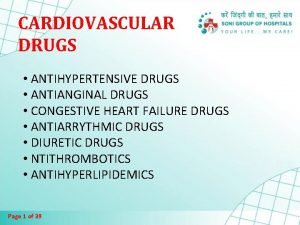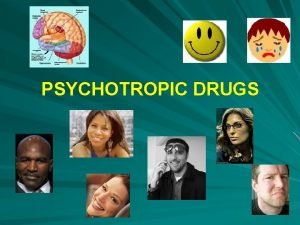Anti Hypertensive Drugs Mrs Jagtap P N HOD















































- Slides: 47

Anti - Hypertensive Drugs Mrs. Jagtap P. N HOD of Pharmacology. PDEA’S SGRS College of Pharmacy. 1

2

Mechanism of regulation of hypertension: 1. Baroreceptors 2. RAAS 3

Physiology of hypertension 4

Classification of Anti- Hypertensive: 5

https: //docs. google. com/forms/d/1 i. NVRzg. Fn_Kz. ABv. Os 4 s. D 7 jp. W 5 fy. NANkyltdd. L 4 Va 0 v. Q/edit? us p=sharing 6

https: //docs. google. com/forms/d/1 WSf. Pbjwa. C 79 u 7 qd. U 2 unpw. Mrus. Iw. Mq. LB 6 Xm 01 AII 4 j. N 4/edit? us p=sharing 7

Diuretics Thiazide diuretics: - Thiazide diuretics, such as hydrochlorothiazide and chlorthalidone, lower blood pressure initially by increasing sodium and water excretion. Thiazide diuretics can induce hypokalemia, hyperuricemia and, to a lesser extent, hyperglycemia in some patients. Loop diuretics: -Inhibitors of epithelial sodium transport at the late distal and collecting ducts (furosemide, and ethacrynic acid) or antagonizing aldosterone receptor (spironolactone, and eplerenone) and reduce potassium loss in the urine. 8

-Aldosterone antagonists have the additional benefit of diminishing the cardiac remodeling that occurs in heart failure. -The loop diuretics act promptly by blocking sodium and chloride reabsorption in the kidneys, even in patients with poor renal function or those who have not responded to thiazide diuretics. -Loop diuretics cause decreased renal vascular resistance and increased renal blood flow. K+ Sparing: - potassium-sparing diuretics (spironolactone, and eplerenone) are competitive antagonists that either compete with aldosterone, or directly block epithelial sodium channel (amiloride). 9

10

ACE inhibitors: -The ACE inhibitors, are recommended as first-line treatment of hypertension in patients with a variety of compelling indications, including high coronary disease risk or history of diabetes, stroke, heart failure, myocardial infarction, or chronic kidney disease. -ACE is also responsible for the breakdown of bradykinin, a peptide that increases the production of nitric oxide and prostacyclin by the blood vessels. Both nitric oxide and prostacyclin are potent vasodilators. 11

- ACE inhibitors decrease angiotensin II and increase bradykinin levels. Vasodilation is result of decreased vasoconstriction (from diminished levels of angiotensin II) and enhanced vasodilation (from increased bradykinin). -By reducing circulating angiotensin II levels, ACE inhibitors also decrease the secretion of aldosterone, resulting in decreased sodium and water retention. -ACE inhibitors reduce both cardiac preload and afterload, thereby decreasing cardiac work. 12

13

� Adverse effects of ACE inhibitors: • The adverse effect profile of all ACE inhibitors is similar. Captopril is well tolerated by most patients, especially if daily dose is kept below 150 mg. • Hypotension: An initial sharp fall in BP occurs especially in diuretic treated and CHF patients • Hyperkalaemia • Cough • Rashes, urticaria • Angioedema 14

• Dysgeusia/ parageusia • Foetopathic • Headache, dizziness, nausea and bowel upset • Granulocytopenia and proteinuria (rare ADR) • Acute renal failure Advantages of ACE inhibitor: • Free of postural hypotension, electrolyte disturbances, feeling of weakness and CNS effects • Safety in asthmatics, diabetics and peripheral vascular disease patients • Long-term ACE inhibitor therapy has the potential to reduce incidence of type 2 diabetes in high risk subjects • No rebound hypertension on withdrawal 15

Advantages of ACE inhibitor: • No hyperuricaemia, no deleterious effect on plasma lipid profile • ACE inhibitors are the most effective drugs for preventing sudden cardiac death in post-infarction patients. However, they are less effective for primary prophylaxis of MI and for preventing left ventricular hypertrophy. Uses of ACE inhibitors • Hypertension: – The ACE inhibitors are first line drugs in all grades of hypertension, but the angiotensin receptor blockers (ARBs) have now surpassed them in popularity. – Essential hypertension respond to monotherapy with ACE inhibitors and majority of the rest to their combination with diuretics or beta blockers 16

Uses of ACE inhibitors • Congestive Heart Failure (CHF): ACE inhibitors cause both arteriolar and venodilatation in CHF patients; reduce afterload as well as preload. • Myocardial infarction: Long-term ACE inhibitor therapy reduces recurrent MI. • Prophylaxis in high cardiovascular risk subjects: ACE inhibitors are protective in high cardiovascular risk subjects even when there is no associated hypertension or left ventricular dysfunction. ACE inhibitors may improved endothelial function. 17

Uses of ACE inhibitors • Diabetic nephropathy: Prolonged ACE inhibitor therapy has been found to prevent or delay endstage renal disease in type I as well as type II diabetics. • Nondiabetic nephropathy: ACE inhibitors reducing proteinuria by decreasing pressure gradient across glomerular capillaries as well as by altering membrane permeability. • Scleroderma crisis: The marked rise in BP and deterioration of renal function in scleroderma crisis is mediated by Ang II. ACE inhibitors produce improvement and are life saving in this condition. 18

Angiotensin antagonists (ARBs) • Angiotensin antagonists: losartan, candesartan, valsartan, telmisartan, olmesartan and irbesartan. • Their pharmacologic effects of ARBs are similar to those of ACE inhibitors. • ARBs produce arteriolar and venous dilation and block aldosterone secretion, thus lowering blood pressure and decreasing salt and water retention. • ARBs do not increase bradykinin levels • ARBs may be used as first-line agents for the treatment of hypertension, especially in patients with a compelling indication of diabetes, heart failure, or chronic kidney disease. 19

Direct renin inhibitor • A selective renin inhibitor, aliskiren directly inhibits renin and, thus, acts earlier in the renin– angiotensin–aldosterone system than ACE inhibitors or ARBs. • It lowers blood pressure about as effectively as ARBs, ACE inhibitors, and thiazides. Aliskiren should not be routinely combined with an ACE inhibitor or ARBs. • Aliskiren cause diarrhea, especially at higher doses, and can also cause cough and angioedema, but probably less often than ACE inhibitors. • Aliskiren is contraindicated during pregnancy. 20

β-adrenergic blockers � β-adrenergic blockers are mild antihypertensives and do not significantly lower BP in normotensives. In stage 1 cases of hypertensive patients (30 - 40%), β adrenergic blockers are used alone. Propranolol • Propranolol is a first β blocker showed effective in hypertension and ischemic heart disease. • Propranolol has now been largely replaced by cardioselective β blockers such as metoprolol and atenolol. • All β-adrenoceptor-blocking agents are useful for lowering blood pressure in mild to moderate hypertension. • In severe hypertension, β blockers are especially useful in preventing the reflex tachycardia that often results from treatment with direct vasodilators. 21

Metoprolol & Atenolol • Metoprolol and atenolol, which are cardioselective, are the most widely used β blockers in the treatment of hypertension. • Metoprolol is atenolol is inhibiting stimulation of β 1 adrenoceptors. • Sustained-release metoprolol is effective in reducing mortality from heart failure and is particularly useful in patients with hypertension and heart failure. • Atenolol is reported to be less effective than metoprolol in preventing the complications of hypertension. 22

Other beta blockers • Nadolol and carteolol, nonselective β-receptor antagonists • Betaxolol and bisoprolol are β 1 -selective blockers • Pindolol, acebutolol, and penbutolol are partial agonists, ie, β blockers with some intrinsic sympathomimetic activity. These drugs are particularly beneficial for patients with bradyarrhythmias or peripheral vascular disease. • Labetalol, Carvedilol, & Nebivolol have both βblocking and vasodilating effects. • Esmolol is a β 1 -selective blocker that is rapidly metabolized via hydrolysis by red blood cell esterases. Esmolol is used for management of intraoperative and postoperative hypertension, and sometimes for hypertensive emergencies, particularly when hypertension is associated with tachycardia or when there is concern about toxicity such as aggravation of severe heart failure. 23

α Adrenergic blockers / Adr receptor blockers/ sympatholytics These drugs inhibit adrenergic responses mediated through the α adrenergic receptors without affecting those mediated through β receptors 24

α 1 Location: Post functional at effector organ Functions: Smooth Muscle contraction Gland: Secretions Gut : Relaxed Agonist: Phentolamine Antagonist: Prazosine α 2 Location: Pre junctional at nerve ending Pancreatic beta cells, BV, Platelets Functions: decresed transmitter release, vasocnstriction, Decresed central sympathetic flow Agonist: Clonidine Antagonist: Yohimbine 25

CLASSIFICATION I. Nonequilibrium type (i) β-Haloalkylamines—Phenoxybenzamine. II. Equilibrium type (competitive) A. Nonselective (i) Ergot alkaloids—Ergotamine, Ergotoxine (ii) Hydrogenated ergot alkaloids—Dihydroergotamine (DHE), Dihydroergotoxine (iii) Imidazolines—Tolazoline, Phentolamine (iv) Miscellaneous–Chlorpromazine B. α 1 selective—Prazosin, Terazosin, Doxazosin, Tamsulosin C. α 2 selective—Yohimbine 26

27

28

29

GENERAL EFFECTS OF α BLOCKERS 1. Vasodilators 2. Refelx tachycardia 3. Nasal Stiffness 4. Miosis 5. Increase intestinal motility 6. Decreases rebal blood flow 7. Tone of SM of Sphincter & Prostate 8. Prazosin is found to decreases LDL & TG increases HDL Not affects 1. Adr cardiac Stimulation 2. Bronchodilation 3. Metabolic changes 30

Phenoxybenzamine It cyclizes spontaneously in the body giving rise to a highly reactive ethyleniminium intermediate which reacts with α adrenoceptors and other biomolecules by forming strong covalent bonds. The α blockade develops gradually (even after i. v. injection) and lasts for 3– 4 days. The fall in BP caused by phenoxybenzamine is mainly postural because venodilatation is more prominent than arteriolar dilatation 31

Phenoxybenzamine is lipid soluble, penetrates brain and can produce CNS stimulation, nausea and vomiting on rapid i. v. injection. However, oral doses produce depression, tiredness and lethargy. Major side effects are postural hypotension, palpitation, nasal blockage, miosis. Pharmacokinetics Oral absorption is erratic and incomplete; i. m. and s. c. injections are very painful—should not be given. Though most of the administered dose is excreted in urine in 24 hours, small amounts that have covalently reacted remain in tissues 32

Natural and hydrogenated ergot alkaloids Ergot alkaloids are the adrenergic antagonists with which Dale demonstrated the vasomotor reversal phenomenon. The amino acid alkaloids ergotamine and ergotoxine are partial agonists and antagonists at α adrenergic, serotonergic and dopaminergic receptors. The amine alkaloid ergometrine has no α blocking activity. The natural ergot alkaloids produce long lasting vasoconstriction which predominates over their α blocking action—peripheral vascular insufficiency and gangrene of toes and fingers occurs in ergotism. 33

Ergotoxine is a more potent α blocker and less potent vasoconstrictor than ergotamine. Hydrogenation reduces vasoconstrictor and increases α blocking activity. The α blockade produced by clinical doses of ergot alkaloids is low grade and short lasting; they are not employed for this purpose. The principal use is in migraine. Diagnostic use of ergotamine has been made to precipitate ECG signs of ischaemia in coronary artery disease. Dihydroergotoxine has been used as a cognition enhancer. 34

Tolazoline It is an imidazoline compound with complex pharmacological properties. The α blocking action is only modest and short lasting. In addition, it is a direct vasodilator and stimulates the heart. Tolazoline also blocks 5 -HT receptors, has a histamine like gastric secretagogue and ACh like motor action on intestines. It was used in peripheral vascular diseases and pulmonary hypertension of the newborn. 35

Phentolamine This congener of tolazoline is a rapidly acting α blocker with short duration of action (in minutes). It equally blocks α 1 and α 2 receptors—NA release is increased and venodilatation predominates over arteriolar dilatation. It is used as a quick and short acting α blocker for diagnosis and intraoperative management of pheochromocytoma and for control of hypertension due to clonidine withdrawal, cheese reaction, etc. It is the most suitable α blocker for local infiltration to counteract vasoconstriction due to extravasated NA/DA during their i. v. infusion. 36

Prazosin It is first of the highly selective α 1 blockers. All subtypes of α 1 receptor (α 1 A, α 1 B, α 1 D) are blocked equally. It blocks sympathetically mediated vasoconstriction and produces fall in BP which is attended by only mild tachycardia; NA release is not increased due to absence of α 2 blockade. Prazosin dilates arterioles more than veins. Postural hypotension is less marked, occurs especially in the beginning, which may cause dizziness and fainting as ‘first dose effect’. 37

This can be minimized by starting with a low dose and taking it at bedtime. Subsequently tolerance develops to this side effect. Other α blocking side effects are also milder. It also inhibits phosphodiesterase which degrades c. AMP. Rise in smooth muscle c. AMP could contribute to its vasodilator action. Prazosin is effective orally (bioavailability ~60%), highly bound to plasma proteins (mainly to α 1 acid glycoprotein), metabolized in liver and excreted primarily in bile. Its plasma t½ is 2– 3 hours; effect of a single dose lasts for 6– 8 hours. 38

Terazosin It is chemically and pharmacologically similar to prazosin; differences are higher bioavailability (90%) and longer plasma t½ (~12 hr); a single daily dose lowers BP over 24 hrs. Terazosin is more popular for use in BHP due to single daily dose Doxazosin Another long acting (t½ 18 hr) congener of prazosin with similar pharmacological profile, used in hypertension and BHP. 39

Tamsulosin This uroselective α 1 A/α 1 D blocker has been found as effective as terazosin in improving BHP symptoms. Because α 1 A subtype predominate in the bladder base and prostate, while α 1 B receptors are dominant in blood vessels, tamsulosin does not cause significant changes in BP or HR at doses which relieve urinary symptoms. No increase in adverse cardiovascular events, including postural hypotension has been noted. Dizziness only significant side effect. Its plasma t½ is 6– 9 hrs, but the modified release (MR) cap needs only once daily dosing. It appears to be a better tolerated α 1 blocker for BHP. 40

Yohimbine A n alkaloid from West African plant Yohimbehe. It is a relatively selective α 2 blocker with short duration of action. Also blocks 5 -HT receptors. Heart rate and BP are generally elevated due to increased central sympathetic outflow as well as peripheral NA release. Other CNS effects include excitation, tremor, ADH release (antidiuresis), nausea and vomiting. This effect is only psychological, but can overcome psychogenic impotence in some patients. There are no valid indications for clinical use of yohimbine. Chlorpromazine α adrenergic blocking activity— cause fall in BP, nasal stuffiness and inhibition of ejaculation as side effect 41

Uses: 1. Pheochromocytoma 2. Hypertension 3. Benign hypertrophy of prostate (BHP) 4. Peripheral vascular diseases 5. Congestive heart failure (CHF) 42

Centrally acting adrenergic drugs Clonidine • Clonidine acts centrally as an α 2 agonist to produce inhibition of sympathetic vasomotor centers, decreasing sympathetic outflow to the periphery. This leads to reduced total peripheral resistance and decreased blood pressure. At present, it is occasionally used in combination with a diuretic. Methyldopa • It is an α 2 agonist that is converted to methylnorepinephrine centrally to diminish adrenergic outflow from the CNS. It is mainly used for management of hypertension in pregnancy, where it has a record of safety. 43

Vasodilators • Hydralazine/Dihydralazine and minoxidil not used as primary drugs to treat hypertension. These vasodilators act by producing relaxation of vascular smooth muscle, primarily in arteries and arterioles. This results in decreased peripheral resistance. • Both agents produce reflex stimulation of the heart, resulting in the competing reflexes of increased myocardial contractility, heart rate, and oxygen consumption. • Hydralazine is an accepted medication for controlling blood pressure in pregnancy induced hypertension. This drug is used topically to treat male pattern baldness. 44

Treatment of hypertension Hypertensive emergency: • It is rare but lifethreatening condition (systolic BP >180 mm Hg or diastolic BP >120 mm Hg with evidence of impending or progressive target organ damage such as stroke, myocardial infarction). • A variety of medications are used, including calcium channel blockers (nicardipine and clevidipine), nitric oxide vasodilators (nitroprusside and nitroglycerin), adrenergic receptor antagonists (phentolamine, esmolol, and labetalol), the vasodilator hydralazine, and the dopamine agonist fenoldopam. 45

Resistant hypertension: � It is defined as blood pressure that remains elevated despite administration of an optimal three-drug regimen that includes a diuretic. � The most common causes of resistant hypertension – poor compliance – excessive ethanol intake – concomitant conditions (diabetes, obesity, sleep apnea, hyperaldosteronism, high salt intake, metabolic syndrome) – concomitant medications (sympathomimetics, nonsteroidal antiinflammatory drugs, or antidepressant medications) – insufficient dose/ drug 46

References: � www. slideshare. com, ppt on Anti-hypertensive drugs, by S. Parasuraman. � www. slideshare. com, � ppt on Anti-hypertensive drugs. K. D. Tripathi. 47
 Anti a anti b anti rh blood type
Anti a anti b anti rh blood type Aminoglycoside
Aminoglycoside Anti diarrheal drugs list
Anti diarrheal drugs list Antidiuretic drugs
Antidiuretic drugs Sympatholytic classification
Sympatholytic classification Classification of antiasthmatic drugs
Classification of antiasthmatic drugs They are mrs garcia and mrs castro
They are mrs garcia and mrs castro Mrs. darling was ___________ of mrs. s.
Mrs. darling was ___________ of mrs. s. They are mrs garcia and mrs castro
They are mrs garcia and mrs castro Crao vs crvo
Crao vs crvo Hypertensive urgency
Hypertensive urgency Meto zerok gewichtszunahme
Meto zerok gewichtszunahme Hypertensive urgency
Hypertensive urgency Increase bp
Increase bp Modified scheie classification of hypertensive retinopathy
Modified scheie classification of hypertensive retinopathy Hypertensive uveitis
Hypertensive uveitis Hypertensive urgency vs emergency
Hypertensive urgency vs emergency Hypertensive emergency vs urgency
Hypertensive emergency vs urgency Bav+
Bav+ Endorine
Endorine Anatomy blood vessels
Anatomy blood vessels Case scenario for hypertension
Case scenario for hypertension Hypertensive emergency
Hypertensive emergency Thyroid storm pathophysiology
Thyroid storm pathophysiology Hypokalemia
Hypokalemia Hypertension urgency vs emergency
Hypertension urgency vs emergency Hod mincou
Hod mincou Hod roles and responsibilities
Hod roles and responsibilities Mantra hod
Mantra hod Hod mincou
Hod mincou Pijetlov hod
Pijetlov hod Pansitopenia adalah
Pansitopenia adalah Caps foundation phase assessment plan
Caps foundation phase assessment plan Le fort prelomi
Le fort prelomi Neonatal sepsis symptoms
Neonatal sepsis symptoms Siafihod
Siafihod Světový rekord hod diskem
Světový rekord hod diskem Prefixes super anti auto
Prefixes super anti auto Dr proesmans rudy
Dr proesmans rudy Example of a skew symmetric matrix
Example of a skew symmetric matrix Raynaud's disease lupus
Raynaud's disease lupus Pph management
Pph management Anti political dynasty act
Anti political dynasty act Anti phishing phil
Anti phishing phil Oracle semi join
Oracle semi join Prophylaxie oslérienne
Prophylaxie oslérienne Imperialists vs. anti-imperialists
Imperialists vs. anti-imperialists Quotes from anti federalists
Quotes from anti federalists
